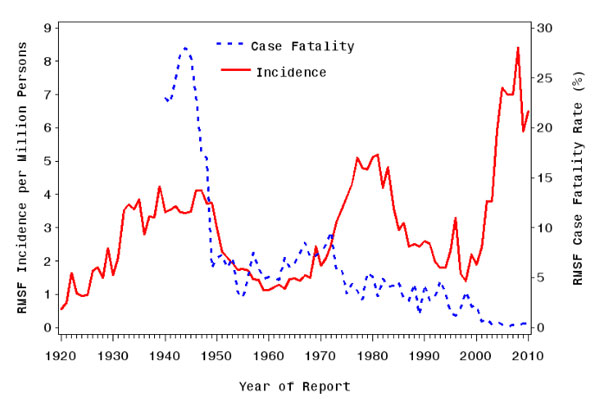Rocky mountain spotted fever


Classification
Taxonomy
Bacteria; Proteobacteria; Alpha Proteobacteria; Rickettsiales; Rickettsiaceae; Spotted fever group
|
NCBI: Taxonomy |
Rickettsia rickettsii
Description
Rocky Mountain Spotted Fever is the disease associated with infection by Rickettsia rickettsii. R. rickettsii is a small rod shaped bacterium that lives within the cytoplasm of a host cell. It requires an arthropod for transmission to a human host typically through bite and is known to be caused primarily by tick bites. Rocky Mountain Spotted Fever can also infect other mammals, particularly dogs. The disease is characterized by a skin rash called purpura or petechiae, though the rash can occur up to five days after the onset of the other symptoms including fever, nausea, vomiting, headache, muscle pain, and depression.[6]
Pathology


Symptoms
Symptoms of RMSF include rash, fever, depression, nausea, vomiting, and muscle pains. The rash appears in 90% of patients, though fever and other symptoms often proceed the rash by 2-5 days. After the 6th day of infection, a petechial (red to purple spotted rash) occurs in 35-60% of patients and is indicative of severe disease progression. RMSF can be fatal within 8 days if not properly treated. [7]
Treatment
The primary treatment for RMSF in adults is 100 mg of the antibiotic Doxycycline every 12 hours for 7-14 days. The standard treatment for children is 45kg of Doxycycline every 12 hours for 7-14 days. Doxycycline is the treatment of choice because it is associated with the lowest fatatily of treatments used for RMSF. Alternate treatments include other antibiotics, but are not recommended by the CDC due to higher risk of patient death. [8]
Transmission
Damage Response Framework
Epidemiology

Socioeconomic Effects
Demographics
Prevention
Biotechnology
Bioterrorism
Page in progress by Cassandra Long, student of Tyrrell Conway
